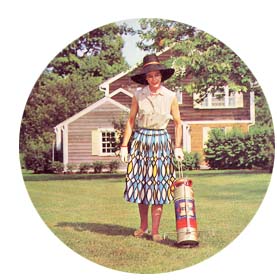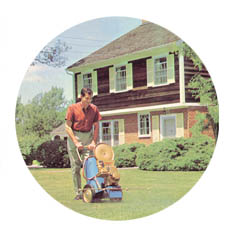
“The sky above… was the colour of television tuned to a dead channel.” — William Gibson, “Necromancer”
Most of all, it is the lawns which are sinister. Fuji green and expansive, they are a visual relief to the freeway and its accompanying tunnel vision. Even ahead of the golden arches, they are welcoming as the approach of a new urban sign-value. The frenzy sites of a decaying Christian culture where reclining lawn chairs, people in the sun, barbecues and summer-time swimming pools can give off the pleasant odors of an imploding Calvinist culture, playing psychologically at the edge of the parasite and the predator.
And the Fuji green lawn? That has already been chemically sprayed to prevent the return of the animal kingdom. And why not? The suburban lawn can be so pleasantly malevolent because it is the aesthetic playground where three bourgeois ideological values intersect: a happy celebration of private property values; the ascendant sign-value of leisure time activity as the prime morality of post-liberal society; and the principle of exclusivity (from sexual relations to family recreation) as the rising star of Christian culture at the end of the twentieth-century.
Indeed, in the old days, lawns were only for English aristocracy who could afford their maintenance. Today, all of this has been swiftly reversed, and we all do obedience to the lawn, that is if we have not paved it. This is a nice irony given the history of paving stones in the struggle for bourgeois freedom. In the suburban suicide sites – on those chemically glowing lawns – the struggle has been won.
In advanced capitalist society, the majority of us live in suburbs. Effectively, this relegates the old sociological paradigm of city/country, along with the fortress mentality, to the trash can.

Lawn care, a real growth industry, replicates the same economic activity as the cosmetics industry a decade earlier. Keeping America beautiful now requires the cosmetics' approach to space…
In these pleasurable sites of indifferent suicides, mutant biology also explodes into vacant fields transforming them into social networks on the grid pattern of urban development. The measured lawns indicate a new social cosmology reflecting the changing face of the suburbanite. Lawn care, a real growth industry, replicates the same economic activity as the cosmetics industry a decade earlier. Keeping America beautiful now requires the cosmetics’ approach to space, as the mirroring of the cosmology of the lived experience of the self. The fusion of the lawn care specialist and the beautician creates the “unconsciousness” of post-hoc suburban life. The aestheticization of all the post-lawns as the ruling metaphysic, then, of the new middle class.
Politically, the impact of the shedding of the city by the suburb has led to the practical abolition of resistance and rebellion. Where modernity linked urban centers by communication routes, postmodernity differs through the creation of suburbs as sites of minimal power. As a low intensity field, the suburb has multiple points of entry and exit, making it invulnerable to attack by any conventional political means short of bureaucracy. Biologically driven, the suburban epicenters appear much like weeds in a field, constantly bleeding the central claims to power whether this be of a capital or of a garden. Having permanently left the city for a safer site, power can only be reconstituted in the absences by media holograms. Having lost any legitimate claim on the real, the city is forced by the suburb to engage in fictive and hyper-aesthetic claims as a way of governing the imitative process.
Ultimately, the origin of the suburb could be traced to the demos in classical thought. The country, or what is outside the city, has successfully appropriated the political posture of democracy, changing forever the way in which citizens and assemblies are constructed. No longer the participatory democracy of the New England town assemblies, but now, suburban democracy or life outside the class-ridden town or city of former times, as a gyroscope to political activity. Similar to the reaction one gets to the request to load the dishwasher, local suburban politics has a dampening effect on life. Having shed class politics, suburban democracy also has little need for interest-group politics. Here, politics has to do with the aestheticization of lifestyle: boundaries (roads), waste systems (sewers), education and recreation for the young, and the prevention of the wholesale invasion of private property – continued small invasions of the property principle being acceptable. True to the spirit of indifference, the suburbanite only calls for a limited immune response to parasitical intrusion.
The political stability of the suburb comes from the large number of cloned, constituted spaces such as plazas, which ensure that the organism will replicate and be preserved. The genotype is easily recognizable through the sequencing of fast food restaurants, car dealerships, gas bars, carpet outlets, and discount stores. Of course, there are no politics here. In fact, there is nothing to do other than to grow. This biological metaphor is pursued vigorously in other growth areas: tennis, bridge, bible study groups and exercise classes.
From the beginning, TV producers have recognized that their edge is in furthering and exploiting this boredom. Thus, the initial success of the soaps and of TV itself. Without the suburbs, TV would not have so easily displaced other forms of cultural activity. So complete has been the suburban cultural victory (entertainment as the growth industry par excellence) that culture could only turn to TV through the PBS (Public Broadcasting System), which emerged from the mutual desperation (for suburban attention) of the centralized state and of equally centralized cultural organizations. This cultural foray against the spreading indifference of green lawns cannot compete against the postmodern “rural idiocy” (Marx), or as Blake has it, “vegetable consciousness.”
The future of America may or may not bring a black President, a woman President, a Jewish President, but it most certainly always will have a suburban President. A President whose senses have been defined by the suburbs, where lakes and public baths mutate into back yards and freeways, where walking means driving, where talking means telephoning, where watching means TV, and where living means real, imitation life.
…
Panic Suburbs was originally published in “Panic Encyclopedia” by Arthur and Marilouise Kroker, New World Perspectives, Cultural Texts Series, 1989. Reprinted by permission.